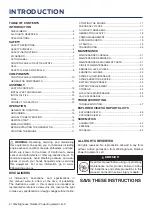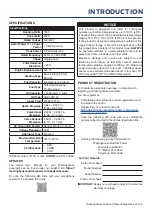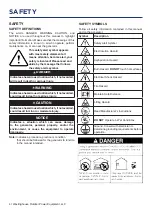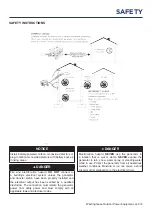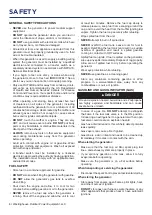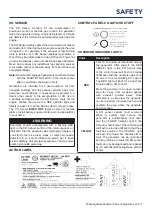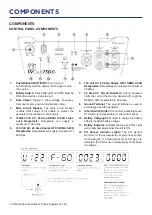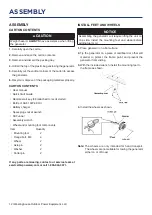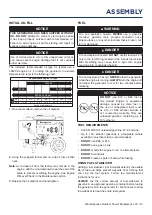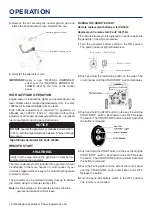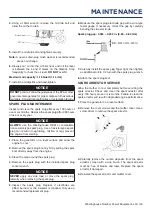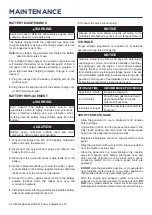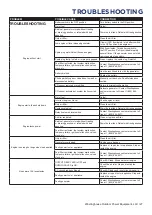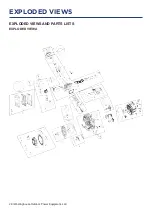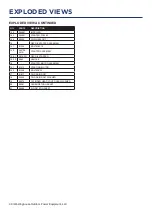
Westinghouse Outdoor Power Equipment, LLC | 15
OPERATION
OPERATION
GENERATOR LOCATION
Read and understand all safety information before starting
the generator.
NEVER
operate the generator inside any building, including
garages, basements, crawlspaces, sheds, enclosure, or
compartment, including the generator compartment of a
recreational vehicle.
DANGER
Electrocution hazard.
NEVER
use the generator in
a location that is wet or damp.
NEVER
expose the
generator to rain, snow, water spray, or standing water
while in use. Protect the generator from all hazardous
weather conditions. Moisture or ice can cause a short
circuit or other malfunction in the electrical circuit. Using
a generator or electrical appliance in wet conditions,
such as rain or snow, or near a pool or sprinkler system,
or when your hands are wet, could result in electrocution
WARNING
Fire hazard. Only operate the generator on a solid, level
surface. Operating the generator on a surface with loose
material such as sand or grass clippings can cause debris
to be ingested by the generator that could block cooling
vents or the air intake system. Allow the generator to
cool for 30 minutes before transport or storage.
The generator should be on a flat, level surface at all times
(Even while not in operation). The generator must have
at least 5 ft. (1.5 m) of clearance from all combustible
material.
DO NOT
operate the generator in the back of a SUV,
camper, trailer, truck bed (regular, flat, or otherwise), under
stairs, next to walls or buildings, or in any other location
that will not allow for adequate cooling of the generator
and/or the muffler.
DO NOT
contain generators during
operation.
DANGER
Asphyxiation hazard. Place the generator in a well-
ventilated area.
DO NOT
place the generator near vents
or intakes where exhaust fumes could be drawn into
occupied or confined spaces. Carefully consider wind
and air currents when positioning the generator.
GROUNDING
WARNING
Shock hazard. Failure to properly ground the generator
can result in electric shock.
NOTICE
Only use grounded 3-prong extension cords, tools, and
appliances, or double-insulated tools and appliances.
The generator neutral is bonded to the frame. There is a
permanent conductor between the generator (stator wire)
and the frame. If this generator will be used only with cord
and plug equipment connected to the receptacles mounted
on the generator, National Electric Code does not require
that the unit be grounded. However, other methods of
using the generator may require grounding to reduce the
risk of shock or electrocution.
Before using the ground terminal, consult a qualified
electrician, electrical inspector, or local agency having
jurisdiction for local codes or ordinances that apply to the
intended use of the generator.
DISCONNECTING THE BONDED NEUTRAL
Removing the bonded neutral disables the GFCI protection
from the 5-20R receptacles. The bonded neutral should
only be removed under specific circumstances. Consult a
qualified electrician to determine if your situation requires
disconnecting the bonded neutral.
1.
Remove the alternator cover.
2.
Remove the bonded jumper wire and reinstall the nut.
Содержание WGen7500c
Страница 9: ...Westinghouse Outdoor Power Equipment LLC 9 SAFETY LABELS AND DECALS SAFETY...
Страница 11: ...Westinghouse Outdoor Power Equipment LLC 11 COMPONENTS GENERATOR COMPONENTS...
Страница 28: ...28 Westinghouse Outdoor Power Equipment LLC EXPLODED VIEWS AND PARTS LISTS EXPLODED VIEW A EXPLODED VIEWS...
Страница 31: ...Westinghouse Outdoor Power Equipment LLC 31 EXPLODED VIEW B EXPLODED VIEWS...
Страница 34: ...34 Westinghouse Outdoor Power Equipment LLC SCHEMATICS SCHEMATICS SCHEMATICS...


